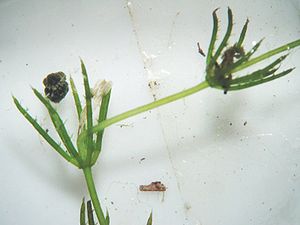Fine candelabrum algae
| Fine candelabrum algae | ||||||||||||
|---|---|---|---|---|---|---|---|---|---|---|---|---|

Fine candlestick alga ( Chara virgata ) |
||||||||||||
| Systematics | ||||||||||||
|
||||||||||||
| Scientific name | ||||||||||||
| Chara virgata | ||||||||||||
| Kützing |
The fine candelabrum algae ( Chara virgata , Syn . : Chara delicatula C.A. Agardh ) is a monoecious species from the candelabrum algae family (Characeae).
Occurrence
The fine chandelier alga occurs in oligotrophic to mesotrophic clear water lakes, which are poor in lime and are often in the acidic range. It is common in those landscapes whose climate is conducive to bog formation. Above all, this is the north German lowlands, but also parts of France, Scotland and Ireland. Otherwise the alga is often found in Poland, Norway and Sweden. Their distribution area extends from the Iberian Peninsula to Siberia and North America. Some representatives are also said to occur in India. Their populations are particularly threatened by the increasing eutrophication of water bodies. The fine candlestick alga is also rarer than its close relative, fragile candlestick alga ( Chara globularis ).
Identifying features
The fine candelabrum forms a 6–20 cm long thallus . The main rungs can reach a diameter of 0.6 mm and are branched from the bottom. The rungs often appear rough and encrusted. Both the internodes, which can be much shorter or partly longer than the branches, and the radii (articulated side rungs) are spiked. The rungs have three times as many bark threads as radii and are therefore triplostich, whereby the middle rows can often stand out clearly. The two-row spines (stipulars) are fine and are mostly scattered. They are short and wart-shaped and sit on the edges of the bark. The branches are 7 or 8 in the whorl, of which mostly only 5 to 7 are barked and have a two- to three-cell short, barkless terminal link. There are often small nodules on the foothills.
The gametangia are formed from summer to autumn and stand in two or three pairs on the barked knots. The oogon is surmounted by the anterior fertile leaflets, the posterior leaflets on the sterile nodes are shorter. The oogon has 13 to 15 turns and is about 0.9 mm high and 0.8 mm wide. It has a crown about 0.15 mm long at the top. The black oospore is only 0.7 mm long, 0.5 mm wide and has 11 to 13 ribs. The antheridium has a diameter of about 0.45 mm. All cells have 24 chromosomes.
literature
- Werner Krause, Hanuš Ettl , Georg Gärtner, H. Heynig, D. Mollenhauer: Freshwater flora of Central Europe. Volume 18: Charales (Charophyceae) . - Gustav Fischer Verlag, 1997. ISBN 3-437-25056-6


